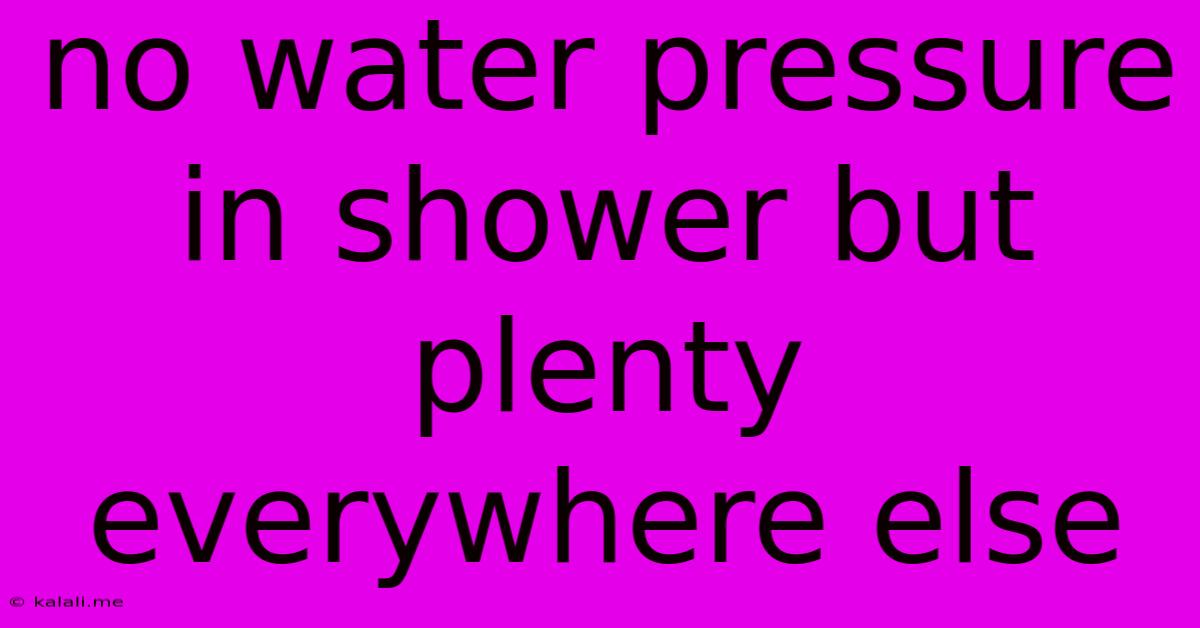No Water Pressure In Shower But Plenty Everywhere Else
Kalali
May 19, 2025 · 4 min read

Table of Contents
No Water Pressure in Shower But Plenty Everywhere Else: Troubleshooting Guide
Are you experiencing frustratingly low water pressure in your shower, while the rest of your house enjoys a perfectly normal flow? This common plumbing issue can stem from several sources, and thankfully, many are fixable without calling an expensive plumber. This guide will walk you through the most likely culprits and how to troubleshoot them. We'll cover everything from simple checks to more involved repairs, so you can get that satisfying, high-pressure shower back again.
Possible Causes and Solutions:
Here's a breakdown of the common reasons behind weak shower pressure while other faucets operate normally, along with practical solutions:
1. Showerhead Clogging:
- The Problem: Mineral deposits, sediment build-up, or even soap scum can significantly restrict water flow through the showerhead. This is often the easiest fix.
- The Solution: Remove your showerhead and soak it in a solution of white vinegar and water for a few hours, or even overnight. This will help dissolve mineral deposits. Use a small brush (an old toothbrush works well) to gently scrub away any remaining debris. Rinse thoroughly and reinstall. If the showerhead is severely clogged or damaged, replacement might be necessary. Consider a low-flow showerhead for water conservation and potentially improved pressure (some models are designed for optimal pressure even with lower flow rates).
2. Restricted Shower Arm or Pipe:
- The Problem: Similar to the showerhead, the shower arm itself or the pipe leading to it might be clogged with mineral deposits or debris.
- The Solution: This requires more careful investigation. You may need to disconnect the shower arm from the wall (turn off the water supply first!), then inspect the inside of the pipe and the arm for any obstructions. A small flexible snake or wire might help clear out any blockages. Be prepared to deal with some water leakage while you do this.
3. Low Water Pressure Regulator:
- The Problem: A pressure-reducing valve located on the main water line or specifically for your shower might be restricting water flow. This is less common if the other faucets have normal pressure.
- The Solution: Locate the valve (if present). Inspect it for any signs of damage or misadjustment. Consult a plumbing guide or professional if you're unsure how to adjust or repair it. Improper adjustments can cause other plumbing problems.
4. Problems with the Shower Valve:
- The Problem: The shower valve itself, which controls the water flow, may be partially clogged, damaged, or simply worn out. This is more involved than the previous issues and often necessitates replacement.
- The Solution: This often requires a plumber's expertise. Replacing a shower valve is more complex and may involve some demolition and reconstruction. Identify the type of shower valve you have before attempting any repairs.
5. Water Heater Issues (Less Likely):
- The Problem: While less probable if other faucets have normal pressure, issues within the water heater (like sediment buildup) can sometimes impact water pressure, particularly if the problem is only noticeable during hot showers.
- The Solution: Flush your water heater to remove sediment. This should be done periodically regardless of low pressure issues, as it maintains efficiency and prolongs the lifespan of the heater. If the problem persists after flushing, the water heater itself might require servicing or replacement.
6. Air in the Lines:
- The Problem: Trapped air in the plumbing lines can restrict water flow. This is often temporary and resolves itself, or can be cleared relatively easily.
- The Solution: Turn on all the faucets in your house and let them run for a few minutes. This can sometimes help expel the trapped air.
When to Call a Plumber:
If you've tried the above solutions and still have low shower pressure, or if you're uncomfortable working with plumbing, it's best to call a qualified plumber. They have the expertise and tools to diagnose more complex problems accurately and effectively. Problems with the shower valve, main water lines, or water heater are best left to professionals.
By following this troubleshooting guide, you should be well-equipped to tackle the mystery of weak shower pressure and get back to enjoying a powerful and refreshing shower. Remember safety first – always turn off the water supply before attempting any plumbing repairs.
Latest Posts
Latest Posts
-
Expression Meaning With As Much Energy As Possible
May 19, 2025
-
What Comes Once A Year Twice A Month
May 19, 2025
-
Why Is My Clutch Pedal Squeaking
May 19, 2025
-
Melody Played In Conjunction With Another
May 19, 2025
-
What Does Friendship Do In Pokerogue
May 19, 2025
Related Post
Thank you for visiting our website which covers about No Water Pressure In Shower But Plenty Everywhere Else . We hope the information provided has been useful to you. Feel free to contact us if you have any questions or need further assistance. See you next time and don't miss to bookmark.